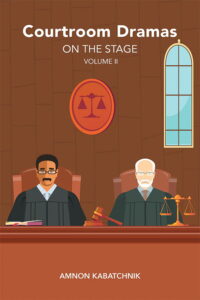 Volume 1 of “Courtroom Dramas on the Stage” deals with trial plays produced in Ancient Greece, Ancient Rome, the Middle Ages, the Elizabethan era, early America, and beyond. Aeschylus, Sophocles, Euripides, Aristophanes, Christopher Marlowe, William Shakespeare, Lope de Vega, Pierre Corneille, Lord Byron, and Nikolas Gogol are among the playwrights represented.
Volume 1 of “Courtroom Dramas on the Stage” deals with trial plays produced in Ancient Greece, Ancient Rome, the Middle Ages, the Elizabethan era, early America, and beyond. Aeschylus, Sophocles, Euripides, Aristophanes, Christopher Marlowe, William Shakespeare, Lope de Vega, Pierre Corneille, Lord Byron, and Nikolas Gogol are among the playwrights represented.
Volume 2 concentrates on trial plays mounted in the twentieth century. The first decade featured notable dramas by Leo Tolstoy (The Living Corpse, Russia, 1900), Alexander Bisson (Madame X, France, 1908), and John Galsworthy (Justice, England, 1910). The trend continued with authors of the main stream penning plays populated with judges, prosecutors, defense attorneys, jurors, witnesses, and the accused, often charged with murder in the first degree — Elmer Rice, Ayn Rand, Ernst Toller, W. Somerset Maugham, Richard Wright, Maxwell Anderson, and Arthur Miller. Herman Wouk, Jean Genet, Aldous Huxley, William Faulkner, William Saroyan, James Baldwin, Terence Rattigan, Jeffrey Archer, Ariel Dorfman, David Henry Hwang, Aaron Sorkin, others.
Veteran mystery writers joined the fray, concocting courtroom melodramas. Among them were Gaston Leroux (The Mystery of the Yellow Room, 1912), A.E.W Mason (No Other Tiger, 1928), Agatha Christie Witness for the Prosecution, 1953), and Henry Cecil (Settled Out of Court, 1960).
Quite a few plays were inspired by real-life events. Caponsacchi (1926) is based on a poem by Robert Browning, depicting a double murder among the clergy in Rome of 1698. Sophie Treadwell’s expressionist drama Machinal (1928) focuses on a sensational 1927 murder case in Queens, New York, in which an ordinary stenographer kills her much older husband when she feels stifled at home. A Pin to See the Peepshow (1951), by F. Tennyson Jesse and H.M. Harwood, introduces a twenty-eight-year-old London millinery who, with the aid of her younger lover, plans to eliminate a bossy husband. On the evening of October 3, 1922, he is found stabbed to death on a side road.
Maxwell Anderson composed two plays about shoemaker Nicola Sacco and fish peddler Bartolomeo Vanzettie who were executed for the 1920 robbery and murder of a paymaster and his guard in Braintree, Massachusetts — Gods of the Lightning (1928) and Winterset (1935). Englishman Terence Rattigan based his play The Winslow Boy (1946) on the case of a young cadet in a naval academy who was accused of stealing a five-shilling postal order and expelled. His father wages a stubborn campaign to clear the boy’s name. Billy Budd (1951), dramatized from a Herman Melville novella, captures incidents aboard the H.M.S. Indomitable during the Napoleonic War, culminating in the hanging of the naive, wide-eyed title character, while Herman Wouk’s The Caine Mutiny Court-Martial (1953) unfolds aboard the S.S Caine in the Pacific during wartime. Arthur Miller’s The Crucible (1953) pictures the 1692 Salem witch trials and is a parable about McCarthyism. Inherit the Wind (1955), by Jerome Lawrence and Robert E. Lee, revives the historic “monkey trial” of a Tennessee teacher accused of instructing Darwin’s theory of evolution in defiance of state law. The main characters of Compulsion (1957), by Meyer Levin, are the youngsters Nathan Leopold and Richard Loeb who conspired to kill a fourteen-year-old boy in order to commit “the perfect murder.” The Andersonville Trial (1959), by Saul Levitt, is based on the official record of the 1865 trial of Henry Wirz, commandant of the notorious Confederate prisoner-of-war stockade. During a hearing in Washington, D.C., Wirz was found responsible for the deaths of fourteen thousand Union soldiers. The German playwright Heiner Kipphardt sifted through 3,000 typewritten pages before completing the docudrama In the Matter of J. Robert Oppenheimer (1964), presenting “the father of the atomic bomb” when summoned to a congressional hearing regarding his security clearance. Donald Freed’s Inquest (1970) deals with the enduring controversy of the cold war trial and execution of Julius and Ethel Rosenberg, accused of delivering notes and charts of a crucial high explosive lens to Russian agents.
The Trial of the Cantonsville Nine (1971), by Daniel Berrigan and Saul Levitt, unfolds in 1968, at the height of the Vietnam War protests. Berrigan, a priest, and eight other Catholic activists, entered the draft board of Cantonsville, Maryland, took hundreds of recruitment files, and set them on fire. The Laramie Project (2000) was created by artistic director Moises Kaufman and members of Tectonic Theatre Project, who in 1998 traveled to Laramie, Wyoming, to interview towns people about the murder of Matthew Shepard, a gay student who was fatally tortured by two local men. A Wicked Soul in Cherry Hill (2022), with words and music by Matt Schatz, is based on a murder that shocked the suburban community of Cherry Hill, New Jersey: the local rabbi fell in love with an attractive radio announcer and hired two hitmen to kill his wife.
The entries, presented chronologically, include a plot synopsis, production data, opinions by critics, and biographical sketches of playwrights and key actors-directors.
 |
Courtroom Dramas on the Stage Vol. I Pages: 506 ISBN 13: 9798887711362 Binding: hardcover, paperback. BearManor Media, bearmanormedia.com |
